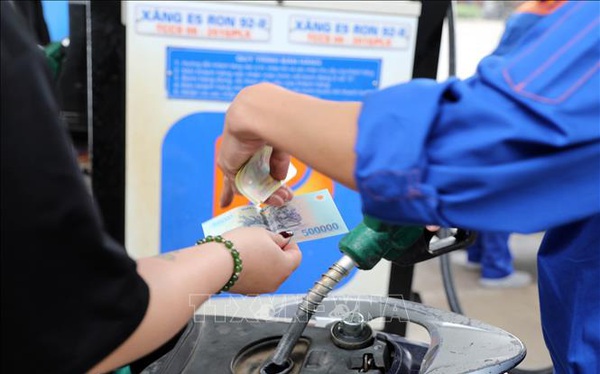The Fed has officially announced a roadmap to raise interest rates – the impact is not much but not subjective
LTS: Dr. Can Van Luc and the authors of the BIDV Training and Research Institute have just published a quick assessment report on the Fed’s move to raise interest rates on March 16 and its impact on Vietnam. We would like to publish information for readers to follow.
——
On the afternoon of March 16, 2022, after the regular meeting in March, the US Federal Reserve (Fed) decided to increase the basic interest rate by 0.25 percentage points; and announced that it will continue to raise interest rates 6 more times in 2022 and 3 times next year. This is the first time the Fed has raised interest rates since March 2020, showing the path of the Fed’s monetary policy change in the direction of ending the asset purchase program, raising interest rates and shrinking the balance sheet. property and is the end of the process of maintaining low interest rates near 0% since the time of the Covid-19 outbreak.
US economic situation
The US economy in 2021 and the first 2 months of 2022 still maintain a positive growth momentum: (i) GDP will grow by 5.7% in 2021, the highest level in 40 years; (ii) the unemployment rate fell to 3.9%, the lowest level since March 2020; (iii) Manufacturing PMI in February 2022 reached 57.3 points, showing that the manufacturing sector is still in a good recovery momentum; (iv) Retail sales in January 2022 increased by 3.8% compared to the previous month, the highest increase in 10 months. However, the US economy is facing challenges, especially inflationary pressure because commodity prices (energy, metals, food…) continue to increase and remain high; in the context that US inflation in February 2022 is at a very high level (7.9% over the same period last year), the highest level in the past 40 years. With this momentum, the Fed forecasts the US economy to grow about 2.8% (from 4% forecast at the beginning of 2022) and inflation to increase to 4.3% in 2022, before falling to 2.7% in 2023.
Two main reasons why The Fed decides interest rate hike
The Fed’s interest rate hike this time is explained by: (i) the US economy has now recovered relatively firmly after the epidemic as well as after a long period of implementing expansionary fiscal and monetary policy. loosen, to support businesses, people and economic recovery. When the epidemic was basically under control and the economy grew steadily, unemployment dropped to 3.8% today. The Fed began implementing an end to its program of asset purchases (a form of quantitative easing – QE), raising interest rates and shrinking its balance sheet as planned; helping the US economy grow more sustainably; (ii) curbing inflation, which has far exceeded the 2% target (as above). Inflation in the US increased sharply from the beginning of 2021 due to both demand-pull factors (the economy recovered quickly after the peak of the epidemic in 2020), input factor prices (petroleum prices, metals, food, etc.) continuously increased. from the second half of 2021, especially since the Russia-Ukraine tension broke out in late February 2022 and the US and the West imposed sanctions on Russia; causing disruption to the goods supply chain, increasing transportation costs; As a result, world commodity and energy prices rise.
Impact on the world economy and Vietnam
For the global economy – finance, in the short term, the Fed’s rate hike by 25 percentage points does not have much of an impact because this is done according to the schedule and has been expected by the market in advance. The market understands that the Fed no longer considers inflation to be temporary and is accelerating the roadmap to raise interest rates to control inflation (currently a great concern of people and investors). Therefore, right after the official decision of the Fed, the global stock market (stock market) reacted positively, such as the US stock market indexes increased from 1.5-3.7%; Asian stock market up 2-4.5%…vv In the medium termIn general, the Fed will raise interest rates about 7 times in 2022, to about 1.9% by year-end and about 3 times in 2023, to nearly 2.7% by the end of 2023, will make the cost of capital and Debt repayments of households and businesses increased, and the US economy’s growth slowed down but became more stable when inflation was gradually controlled and unemployment fell to 3.5% like before the Covid-19 epidemic. The USD appreciated slightly (also because it was forecasted). The positive point this time is that the Fed raises interest rates slowly, with a clear communication and roadmap, so the impact seems to be “softer”.
For Vietnam, in front of eyes, Vietnam’s economy – finance has not been affected much because the interest rate increase is not large (25 percentage points) and has been predicted in advance. Later onespecially from the fourth quarter of 2022, the Fed’s continued increase in interest rates will have clearer impacts on Vietnam’s economy and finance in the world. at least 4 aspects.
Firstly, an increase in global interest rates may slow down the world economy’s growth (because businesses and people consider investment and consumption, especially with more borrowed capital), demand for goods and services decreases; thereby reducing Vietnam’s export demand, which may slow down the economic recovery momentum of Vietnam, in the context that the openness of Vietnam’s economy is at a high level (import-export turnover/GDP is adjusted). adjusted at about 185% in 2021) and the US is Vietnam’s top export partner (in 2021, Vietnam’s exports to the US will reach $96.3 billion, accounting for 28.6% of the country’s total export turnover. VN).
Second, The Fed’s rate hike will cause The USD appreciated against most other currencies, including VND, creating certain pressure on the USD/VND exchange rate.. However, the USD/VND exchange rate is not expected to increase much because: (i) the USD by the end of March 16, 2022 has increased by nearly 3% compared to the end of 2021 when the Fed sent a clear message about the contraction. monetary policy, the coming momentum will be slower; (ii) Vietnam’s foreign exchange reserves are reaching a record high (about 110 billion USD by the end of 2021), contributing to strengthening the buffer against external shocks and stabilizing the exchange rate; (iii) the supply of foreign currency such as remittances, FDI disbursement is forecasted to grow steadily, the trade balance is expected to remain in surplus (estimated at 4-8 billion USD) in 2022; and (iv) The State Bank has maintained its policy of flexible exchange rate management, closely following market movements. Accordingly, Dr. Can Van Luc and the authors of the BIDV Training and Research Institute still keep their forecast that the exchange rate in 2022 will only increase by about 0.5-1%.
Tuesday, interest rate hike of the Fed will work for interest rates tend to increase, causing the cost of new loans and debt repayment obligation in USD get a raise. According to the Public Debt Bulletin of the Ministry of Finance in November 2021, out of the total repayment of foreign loans (both principal and interest) of Vietnam is 112.6 billion USD in 2020, the Government’s part of foreign debt repayment accounts for only about USD 112.6 billion. 3.1% (equivalent to 3.5 billion USD), the rest is from enterprises (109.1 billion USD in conversion – accounting for 96.9%, of which are mainly FDI enterprises – accounting for about 75% of the total amount. data estimated by Dr. Can Van Luc and the authors of the BIDV Research and Training Institute from another related report). Because there is no data on the structure of foreign currency loans, the authors assume that 40% of the government loans are in USD, 65-70% of businesses’ loans are in USD, the rest is in other foreign currencies. When interest rates and USD exchange rate increase, the obligation to repay foreign loans of enterprises (especially FDI enterprises) will increase significantly.
Wednesday, impact on investment capital flows, especially foreign indirect investment. When the Fed raised interest rates, some investors were risk averse, withdrew capital from emerging markets, and returned to invest in the US market and some other developed markets to shelter risks and enjoy interest rates. higher than before. This move happened in 2021. However, Dr. Can Van Luc and the authors of the BIDV Training and Research Institute forecast that foreign investors withdrawing capital (if any) will not be much for the Vietnamese market because Vietnam is still considered an attractive investment market with a large number of investors. : (i) stable political foundation, (ii) rather high economic growth potential (6-6.5%), (iii) basically stable macroeconomics (inflation is under control around 4%) , the exchange rate is quite stable, the trade balance may be in surplus, the budget deficit, the public debt, the Government’s debt repayment obligation increases but is under control…), (iv) the market size is quite large ( nearly 100 million people with a rapidly growing middle class)…vv
Three recommendations for Vietnam
In the context that Vietnam is making efforts to implement the program of socio-economic recovery and development in the period of 2022-2023; to minimize the negative effects of the central banks of other countries, especially the Fed, tend to tighten monetary policy and raise interest rates; Dr. Can Van Luc and the author team of BIDV Training and Research Institute have 3 recommendations as follows.
One is, it is necessary to continue strengthening the coordination of monetary policy, fiscal policy and price management in order to stabilize the macro-economy. Accordingly, it is necessary to: (i) Continue to operate monetary policy proactively and flexibly with scenarios when there is a change in monetary policy of major central banks in the world; well coordinated with fiscal policy, ensuring the stability of interest rates and exchange rates, contributing to curbing inflation according to the target; (ii) Following closely, analyzing and forecasting developments in the international monetary and financial markets, it is necessary to develop a scenario if the Fed rapidly raises interest rates leading to fluctuations in the global financial market.
Two is, it is necessary to develop a roadmap and coordinate to implement the plan to increase the prices of goods under the management of the State (especially gasoline prices, electricity prices, health – education service prices, etc.) in an appropriate manner. Gentle, effective to avoid jerks, inappropriate timing. In addition, it is necessary to strengthen communication and measures to stabilize prices (especially at peak times) to minimize inflation and the phenomenon of “dropping water with the rain”…etc.
Three is, monitor and evaluate foreign debt obligations when the Fed raises interest rates in order to give timely warnings to businesses; continue to operate the exchange rate and foreign exchange market proactively and flexibly in order to stabilize the exchange rate, contributing to controlling inflation and supporting businesses, especially those with large foreign debt.
at Blogtuan.info – Source: cafebiz.vn – Read the original article here



